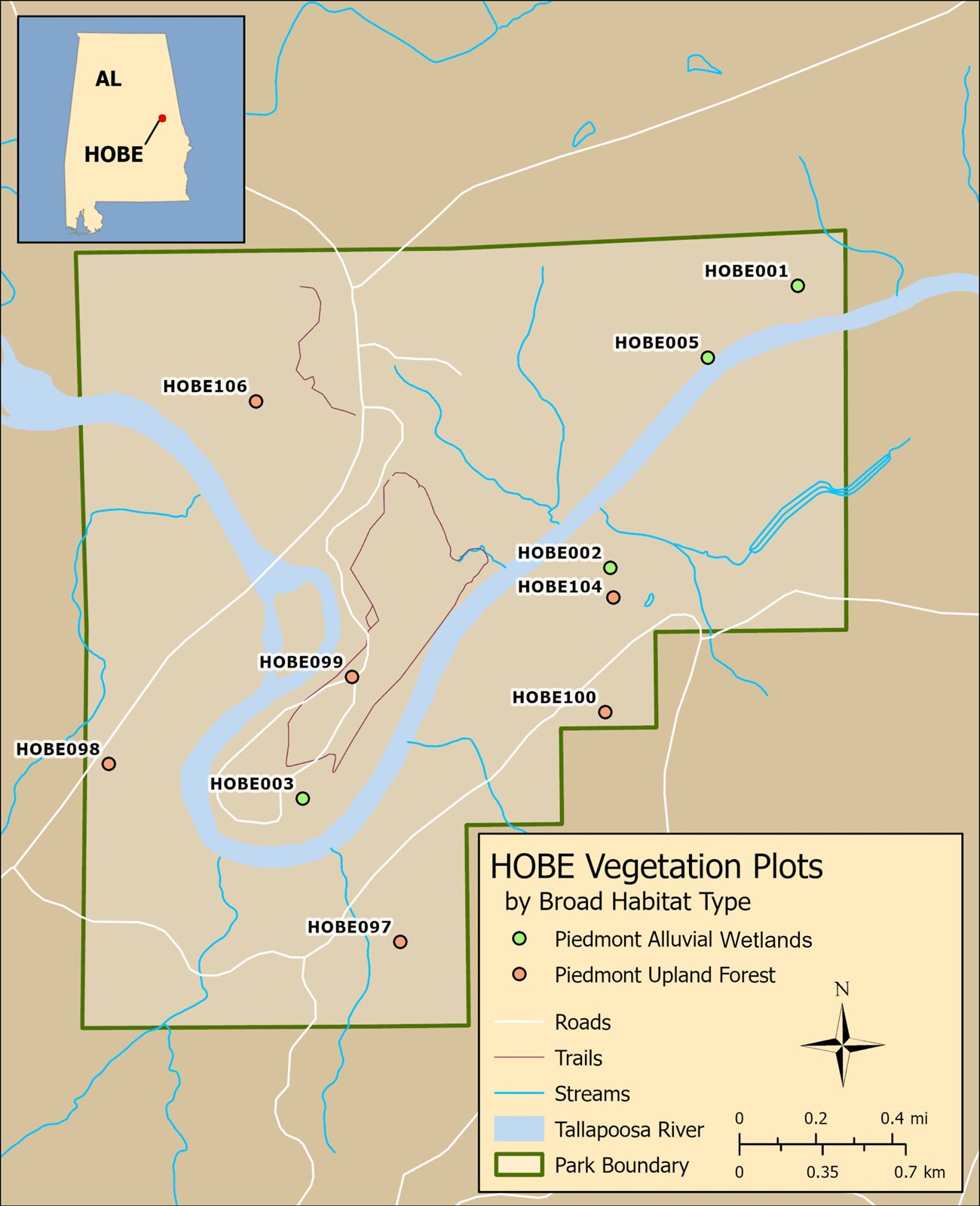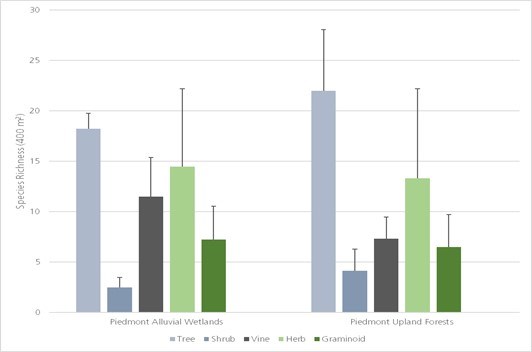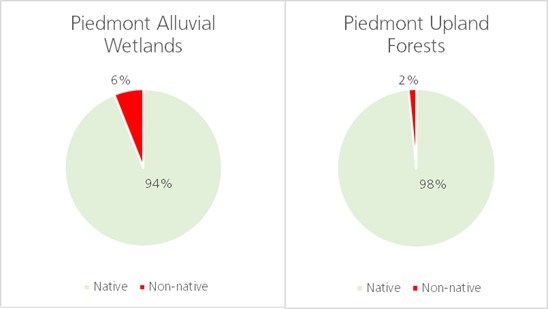Last updated: August 2, 2024
Article
Terrestrial Vegetation Monitoring 2022 Data Summary for Horseshoe Bend National Military Park

Overview
Vegetation communities are dynamic entities influenced by environmental factors and impacts from natural and anthropogenic disturbances. The diversity of plants within the southeastern Coastal Plain contributes to a range of ecological services, provides habitat and resources to an array of wildlife, and functions as nature’s backdrop—usually the primary visual cue pulling us toward an appreciation of the outdoors. Determining trends in vegetation communities over time and identifying plant stressors is therefore vital to understanding the ecological health of terrestrial ecosystems within Southeast Coast Network (SECN) parks. Collectively, this information can be used to guide management actions that sustain a park’s ecological integrity and support plant conservation across a diversity of spatial scales for generations to come.
Methods
The Southeast Coast Network collects long-term data on terrestrial vegetation within its parks using a peer-reviewed protocol similar to other NPS Inventory and Monitoring networks in the eastern U.S. and is modeled after the approach used to describe natural vegetation in the Southeast developed by the Carolina Vegetation Survey. Permanent plots are used as the sample unit to determine a site’s (1) vascular plant richness and abundance for all native and non-native species; (2) basal area, density and health for all woody species; (3) density of forest floor fuels; (4) community level disturbance events, including presence of insect pests and disease; and (5) abiotic condition (e.g., landform shape, soil nutrients, canopy coverage and height). Plots are randomly located across broadly defined habitat types within SECN parks. Our sampling effort focuses on dominant (> 30% coverage) habitat types within these parks, but when time and resources allow, the sampling effort is increased to include less dominant types. The 2019 Terrestrial Vegetation Monitoring Protocol provides detailed descriptions of field and data processing techniques used by the Southeast Coast Network.
Study Area
Horseshoe Bend National Military Park (HOBE) is in eastern-central Alabama (Tallapoosa County) approximately 24 kilometers (15 miles) east of Alexander City. It is named for the horseshoe-shaped meander of the Tallapoosa River, the park’s dominant physical and cultural feature, and a tributary of the Mobile River. The park boundary has not changed significantly since its establishment, and today includes 829 hectares (2,049 acres) of mostly mid-successional pine (Pinus sp.)-mixed hardwood upland forests, mid-successional sweetgum (Liquidambar styraciflua)-pine forests, and park-maintained open fields of the original battlefield. Stressors and threats to vegetation resources are present, many of which are related to large-scale land-use changes of the 19th and 20th centuries, impacts from upstream and downstream dams along the Tallapoosa River, and adjacent land use. This protocol was first implemented at the park in 2022, and these data represent the baseline status of vegetation and associated abiotic elements from the following broadly defined habitats: Piedmont Alluvial Wetlands and Piedmont Upland Forests. Ten plots were established in August 2022 (see map).
Significant Findings
Site and Environmental Factors
Horseshoe Bend National Military Park lies within the Southern Inner Piedmont ecoregion of Alabama. This ecoregion typically has higher elevations and steeper slopes than the rest of the Piedmont, with gneiss and schist rocks yielding nutrient-poor, acidic soil. Like most of the landscape across the southeastern Piedmont, the land that occupies the park has been subjected to profound impacts by humans following European settlement, including conversion of native forests to agriculture and timber land. The distribution and composition of both upland and alluvial forested habitats within the park are largely determined by former land-use patterns, as well as by localized edaphic conditions. Plots established within the park during this monitoring effort were distributed along topographic and landform gradients affecting soil moisture. Xeric upland forests occurred on convex, upper slope positions, submesic to dry forests were located on mid-slope positions with varying aspects, and mesic forests were located in protected, concave lower slope positions; alluvial forests occurred next to rivers and streams on generally flat slopes.

Vegetation
One hundred and ninety-nine plant species were observed across all plots, including 54 taxa not detected in previous plant surveys and one species, butternut (Juglans cinerea), listed as rare by the Alabama Natural Heritage Program. Overall plot level native plant richness ranged from 37 to 72 species within Alluvial Wetlands and 28 to 84 species within Upland Forests. Diversity was highest in the among tree species in both broadly defined habitat types. Non-native species were frequent within Alluvial Wetland plots of the park. Six species listed by the Alabama Invasive Plant Council as invasive within the state were observed in monitoring plots, including one species not previously detected within the park—bull thistle (Cirsium vulgare). Chinese privet (Ligustrum sinense) occurred in all four Piedmont Alluvial Vegetation plots, while Japanese honeysuckle (Lonicera japonica) occurred in three of the four plots.

Other Findings
- Fire scars were observed on three of the six Piedmont Upland Forest plots and one of the four Piedmont Alluvial Vegetation plots. The park initiated a prescribed fire program in 2002 to promote natural regeneration of longleaf pine, reduce fuel loads within park’s forest ecosystems, and manage forests damaged by southern pine beetle.
- Impacts to forest regeneration patterns from overgrazing by white-tailed deer (Odocoileus virginianus) were not observed within either upland or alluvial monitoring plots.
- Of the nine flowering dogwood stems measured within these plots during this monitoring effort, three were dead and four exhibited foliar symptoms likely caused by dogwood anthracnose (Discula destructiva).
- All plots are scheduled to be resampled in spring/summer 2026.
Full Report
Terrestrial Vegetation Monitoring at Horseshoe Bend National Military Park: 2022 Data Summary
About the Southeast Coast Network
In 1999, the National Park Service initiated a long-term ecological monitoring program, known as “Vital Signs Monitoring,” to provide the minimum infrastructure to allow more than 270 national park system units to identify and implement long-term monitoring of their highest-priority measurements of resource condition. The overarching purpose of natural resource monitoring in parks is to develop scientifically sound information on the current status and long-term trends in the composition, structure, and function of park ecosystems, and to determine how well current management practices are sustaining those ecosystems.
The NPS Vital Signs Monitoring Program addresses five goals for all parks with significant natural resources:
- Determine the status and trends in selected indicators of the condition of park ecosystem,
- Provide early warning of abnormal conditions,
- Provide data to better understand the dynamic nature and condition of park ecosystems,
- Provide data to meet certain legal and Congressional mandates, and
- Provide a means of measuring progress towards performance goals.
The Southeast Coast Network (SECN) includes eighteen administrative areas containing twenty park units, fifteen of which contain significant and diverse natural resources. In total, SECN parks encompass more than 184,000 acres of federally-managed land across North Carolina, South Carolina, Georgia, Alabama, and Florida. The parks span a wide diversity of cultural missions, including four national seashores, two national historic sites, two national memorials, six national monuments, two national military parks, as well as a national recreation area, national battlefield, national historical park, and an ecological and historic preserve. The parks range in size from slightly more than 20 to nearly 60,000 acres, and when considered with non-federal lands jointly managed with the National Park Service, the network encompasses more than 253,000 acres.
For More Information
SECN Home Page
(https://www.nps.gov/im/secn/index.htm)
SECN Reports and Publications
(https://www.nps.gov/im/secn/reports-publications.htm)
NPS Inventory and Monitoring Program
(https://www.nps.gov/im/index.htm)
Data Downloads via the Natural Resource Information Portal
(https://irma.nps.gov/portal/)
